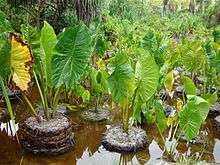Cyrtosperma merkusii
| Cyrtosperma merkusii | |
|---|---|
 | |
| Babai cultivation in Butaritari, Kiribati. | |
| Scientific classification | |
| Kingdom: | Plantae |
| (unranked): | Angiosperms |
| (unranked): | Monocots |
| Order: | Alismatales |
| Family: | Araceae |
| Subfamily: | Lasioideae |
| Genus: | Cyrtosperma |
| Species: | C. merkusii |
| Binomial name | |
| Cyrtosperma merkusii (Hassk.) Schott | |
| Synonyms | |
| |
Cyrtosperma merkusii or giant swamp taro, is a crop grown throughout Oceania and into South and Southeast Asia. It is a riverine and "swamp crop" similar to taro,[1] but "with bigger leaves and larger, coarser roots."[2] It is known as puraka in Cook Islands, "Lak" in Yap (FSM), Babai in Kiribati, pula’a in Samoa, via kan in Fiji, Pulaka in Tokelau and Tuvalu, simiden in Chuuk, swam taro in Papua New Guinea, navia in Vanuatu[3] and palawan in the Philippines.
The same species is also known by the names Cyrtosperma lasioides, Cyrtosperma chamissonis and Cyrtosperma edule.[4]
In the harsh atoll environments of the Central Pacific, especially Tuvalu and Kiribati, swamp taro is an important source of carbohydrates in a diet dominated by fish and coconut. Its cultivation is difficult and time-consuming, and the plant has deep cultural as well as practical significance.[5][6] The roots need to be cooked for hours to reduce toxicity in the corms, but are rich in nutrients, especially calcium.[7] The cultivation of Pulaka in Tuvalu, and babai in Kiribati, is an important cultural and culinary tradition, now under threat from rising sea level and displacement from the growing use of imported food products.
In Nepal, Giant Swamp Taro is called mane and grows in the tropical and sub tropical forests along stream banks. It is gathered in January-February and all plant parts (leaf, stem, rhizomes) are savored after being boiled and roasted. The stem requires prolonged boiling and the water is replaced once to remove irritating chemicals. If cooked carefully, the rhizomes taste like taro and the leaves like spinach. But without careful washing, the food causes an unpleasant tingling or scratchy sensation. [8]
Species
Giant swamp taro is the largest of the root crop plants known collectively as Taro, which are cultivated throughout Southeast Asia and the Pacific. Although outwardly similar to Colocasia esculenta, the most widely cultivated taro, it belongs to a different genus. The plant may reach heights of 4–5 metres, with leaves and roots much larger than Colocasia esculenta. It is relatively resistant to disease and pests but is susceptible to taro beetle. The corm, which can reach weights of 80 kg or more, is starchy and cream or pink in colour, with a taste similar to sweet potato, though it is drier in texture.
Cultivation
Giant swamp taro is not suitable for growing in upland or rainfed conditions; it has adapted to growth within fresh water and coastal swamps. It exhibits some shade tolerance and is considered mildly tolerant of saline growing conditions compared to other taro species; that is, it can be grown in mildly brackish water. It is a slow growing crop which can take up to 15 years to mature.
Giant swamp taro is nearly the only carbohydrate crop that can be cultivated on low-lying coral atolls, where it is grown in purpose-built swamp pits dug to below the level of the freshwater lens. The cultivation of Pulaka in Tuvalu, and of babai in Kiribati, has deep cultural significance. In these harsh environments, its cultivation is increasingly threatened by rising sea levels caused by global warming: the plant does not thrive in brackish water,[9] which rots the roots, turns the leaves yellow, and stunts the plant's growth.[7] Climate change is affecting its cultivation in two ways; more frequent droughts increase the salinity of the freshwater lens, and more extreme high tides and coastal erosion lead to saltwater intrusions where seawater enters the cultivation pits.[10]
Preparation
Giant swamp taro contains toxins which must be removed by long cooking. It may be field stored in the ground for very long periods – up to 30 years or more – and accordingly has traditionally been an important emergency crop in times of natural disaster and food scarcity.[3] The cooked corms can be dried in the sun and stored for later use.[6] Different methods of preparation are used for pulaka in Tuvalu, and babai in Kiribati.
See also
References
- ↑ "Tuvalu could lose root crop". Radio New Zealand. 17 September 2008. Retrieved 10 May 2010.
- ↑ "Leaflet No. 1 - Revised 1992 - Taro". Food and Agriculture Organization. Retrieved 10 May 2010.
- 1 2 "Pacific Food Security Tookit Module 4 - Pacific Root Crops" (PDF). FAO.
- ↑ "ITIS report, Cyrtosperma merkusii". Integrated Taxonomic Information System.
- ↑ Koch, Gerd (1983–1990). The material culture of Tuvalu. Institute of Pacific Studies, University of the South Pacific. p. 46. Retrieved 12 May 2010.
- 1 2 Koch, Gerd (1986). The Material Culture of Kiribati. Institute of Pacific Studies, University of the South Pacific. ISBN 982-02-0008-3.
- 1 2 Gorišek, Saša (April 2010). "Tuvalu Food Security" (PDF). United Nations. Retrieved 12 May 2010.
- ↑ Limbu, Prakash (2012). Nepal Food Culture (PDF). ICIMOD [Kathmandu Nepal].
- ↑ Knox, Angie (28 August 2002). "Sinking feeling in Tuvalu". BBC News. Retrieved 10 May 2010.
- ↑ Corlett, David (27 November 2008). "Tuvalunacy, or the real thing?". Inside. Retrieved 12 May 2010.